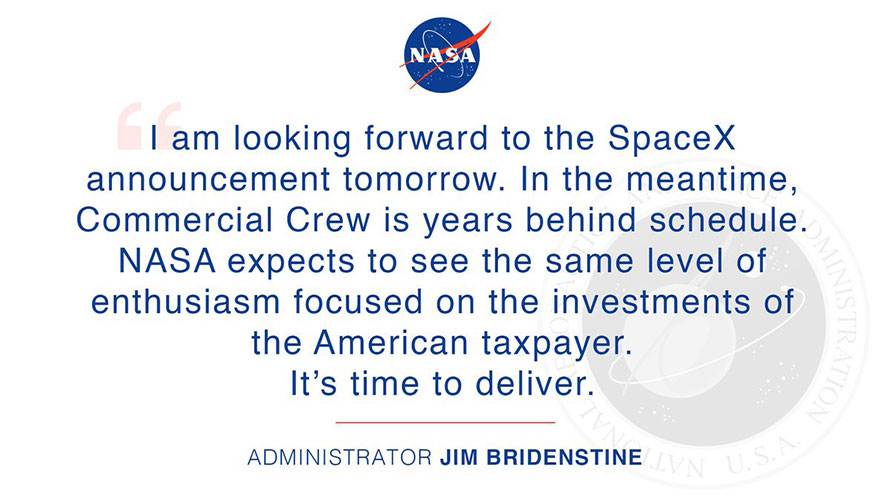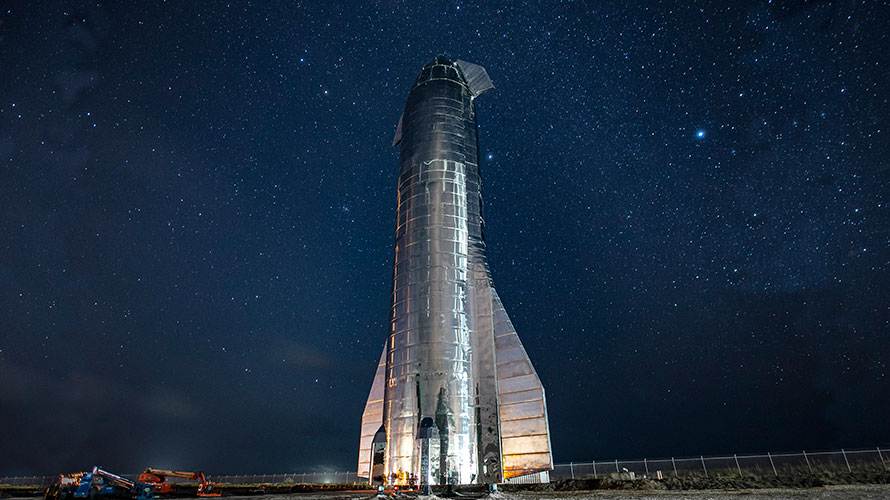Opinion by Dale L. Skran
Just before Elon Musk made his impressive Starship progress update, NASA Administrator Bridenstine tweeted out the following:

This statement left space advocates scratching their heads about what it might mean. There’s been a lot of speculation on this topic, but I don’t have much to add to that discussion. Musk responded during the Q&A after the Starship update that only about 5% of SpaceX resources were being devoted to Starship and the vast majority of resources were devoted to Falcon and Dragon, especially Crew Dragon.
Subsequent statements by Administrator Bridenstine suggest an authentic concern that Dragon 2 will not fly in time to prevent NASA from having to sign up for more (and more expensive) rides to the ISS on the Russian Soyuz. Without stepping into the tarpit, I observe that there are other projects at NASA that are at least as far behind, or further behind than SpaceX Commercial Crew, so it remains unclear why SpaceX is being singled out for attention that logically should be spread more broadly.
However, there is one sentence that merits a closer examination: “NASA expects to see the same level of enthusiasm focused on the investments of the American taxpayer.” This is most easily understood as a complaint that Musk and SpaceX are not sufficiently “enthusiastic” about Commercial Crew and Dragon 2, although precisely what Administrator Bridenstine is looking for here remains unclear.
This can be read another way, namely that NASA expects to see the space interested public as “enthusiastic” about Commercial Crew as they are about Starship. NSS, both by itself and as part of the Alliance for Space Development, has a long history of supporting Commercial Crew. Commercial Crew is important for many reasons, but here are few:
- Commercial Crew will end U.S. reliance on the Russians for access to space by crews.
- Commercial Crew will allow the ISS to support an additional permanent crew member, with a resultant doubling of scientific/commercial productivity.
- Commercial Crew lays the foundation for commercial LEO operations, including support for private space stations and tourism.
- Commercial Crew supports U.S. industry, notably Boeing and SpaceX, in the development of human space support technologies, including space suits and life support systems.
- Commercial Crew will lower the cost of sending crews to the ISS by at least a modest amount.
Commercial Crew is an extremely exciting NASA program, and NSS has gone to bat to support it in the face of Congressional budget cuts many times. That’s a lot to be excited about, and on another day in another year, Commercial Crew might be the major focus of the space interested public. But we don’t live in that alternate universe. We live in a universe in which Elon Musk and SpaceX are embarked on a “committed strike” to build a city on Mars. In the martial arts, a “committed strike” refers to an all-or-nothing move that will bring either complete victory or total disaster. And Starship/Superheavy is the linchpin of such an effort.
Why might the space interested public be enthusiastic about Starship? Here are a few thoughts:
- Starship/Superheavy will, when it flies, be taller and more powerful than the Saturn V.
- Starship/Superheavy will be the first ever fully reusable space vehicle.
- Starship/Superheavy uses sub-cooled methane/lox engines, which has never been done before in a flying vehicle.
- Starship/Superheavy uses a full-flow staged combustion engine, which has never been done before in a flying vehicle
- As a system, Starship/Superheavy will use in-space refueling to launch unprecedented amounts of cargo to deep space.
- The vertical control surfaces of Starship have never been used before in a space vehicle.
- The stainless-steel construction of Starship/Superheavy promises a revolution in low-cost rocket production.
- The anticipated cost to orbit for Starship/Superheavy will slash all previous records, enabling a vast array of new space activities.
- With a 9-meter diameter cargo section, Starship/Superheavy can launch a larger cargo than any previous space vehicle.
- A single Starship in orbit has a comparable interior pressurized volume to the ISS.
- Starship/Superheavy is being developed almost entirely using private funds.
- Starship/Superheavy is being developed with an exceptional degree of transparency to the public, with construction literally proceeding in an open field.
In short, Commercial Crew is a wonderful, essential NASA program. Commercial Crew is a great investment of taxpayer dollars. NSS members are very excited to see Commercial Crew fly – soon. NSS has endorsed competition in Commercial Crew many times, and is especially excited to see both SpaceX and Boeing flying to the ISS. There is at least one more reason to be excited about Commercial Crew: It is providing a vehicle for SpaceX to develop and test key technologies needed for crewed Starship operations, including docking, life support, human-rated flight control systems and space suits.
Having said all that, Starship/Superheavy will be a revolution that surpasses all current limitations on space activities and propels us in a sustainable, cost-effective way to the Moon, Mars and beyond. There is no rocket like it operating anywhere in the world, and no rocket in committed development comes close to its planned range of capabilities.
So, yeah, folks are enthusiastic about it.




















7 thoughts on “SpaceX “Level of Enthusiasm” as viewed by NASA”
Left out of this equation is broader thinking on what is really needed for human mobility in space and on planets. Although we are developing new materials for space suits, we have not even begun thinking of what functions really need to be done in that suit. Why are legs needed in outer space? Why should it take hours to get into a space suit? What would work better is a small one person space capsule that can be quickly entered and that can get the job done better and faster than a legged space suited astronaut, and that could also be operated remotely in place of an astronaut, or to assist an astronaut in a mission.
About “public interest in Starship, you left out that it’s BIG and SHINY. Also, note that SpaceX eliminated the vertical dorsal fin/landing leg and now only have horizontal articulated aft fins and canards. I would expect prototypes and flight tests will proceed at Elon’s ASAP pace, hopefully without explosive lessons learned. If not, they’ll count it as the price of doing business, recover and insert an additional serial number into the program. It’ll slow down when it comes time for NASA, FAA, FCC and everybody’s certifications. It’s really a good combination of systems, Fearless, breakneck, out-of-the-box innovation, then methodical check every box preparation for human rated flight.
The Gerard O’Neill / Peter Glaser / Bill Brown vision, grounded in hard physics and engineering, anticipated the required technologies to fall into place, as they’re hopefully doing now and soon. Early cost/benefit analyses, enabling tech, funding, and politics made it impossible 40-50 years ago.
The discovery of water on the Moon was theorized decades before a craft found it. Cheap reusable launch wasn’t in the NASA playbook, but it is central to the SpaceX and Blue Origin playbooks along with orbital refueling. Lunar ISRU for in-space construction was solidly grounded in university-based mass driver research in the 1970s-1980s, but not doable because of zero funding and a then-nonexistent interlocking of motivations of extremely rich individuals who made their initial wads on unrelated computer apps and enjoyed rather marvelous tax breaks.
But change is coming. Lunar ISRU and manufacturing operations can soon be enabled by the likes of NASA’s Artemis mission in partnership with high-capability private companies like the aforementioned and other interested public/private participants. Let’s hope government doesn’t pull the plug on lunar return with the vagaries of changing administrations. It was previously pulled after Bush 41 left office, restored by Bush 43, and pulled again. Government needs to permanently stick to lunar return to stay. On this point, the US is in direct competition with China and other nations, who are actively pursuing their own space solar power R&D using lunar materials and in-space manufacturing.
Elon Musk has recently dissed space solar power and shielded 1g free-space habitats, the core of the O’Neill / Glaser / Brown vision. So, what’s up with that? A bit of a ribbing of Jeff Bezos, the most prominent current exponent of the vision?
It appears Musk’s engineering and laudable frenetic pace of development and the visioneers’ confirming numbers as championed by Bezos are converging. Musk should know that Teslas can be refueled anywhere on Earth by beamed satellite power. A worldwide network of hyperloops can be run by sunsats.
I believe the message Bridenstein is sending to all involved, including the taxpayers, NASA, contractors, employees and even Congress is – “Crank It Up cause we are gonna LAUNCH!” (Trump would probably add an “or else…”) But Wow, that image! If all goes well, like the photo of the LEM on the Moon, that vision of what is the first real Starship, standing in the field it was being built, will become an icon, a legacy throughout history. With luck, God’s grace and hard work – this is a shot at an optimistic future, where a science fiction movie about a boy from Iowa, can became reality. A future where many other much larger Starships hang above fields like this one as they are being built.
On the one hand, Bridenstine may be trying to chivvy Musk into getting Crew Dragon qualified to carry NASA astronauts before the U.S. has to buy another seat on Soyuz. If so, that is a violation of proper management techniques. You don’t bawl out or criticize subordinates or contractors in public! OTOH, SpaceX isn’t that far behind. All they need to do is fly the maxQ abort flight successfully and then launch a Dragon2 with a couple of astronauts aboard to the ISS. While SpaceX hasn’t offered details of the modifications being made and verified in the CrewDragon spacecraft, I’m sure they are pushing ahead as quickly as practicable. After all, this business of pushing ahead even if you aren’t really ready is what got us Challenger! As old NACA/NASA hand and pioneer Walt Williams has been quoted as saying, “You don’t get medals for on-time failures!” It will be interesting to see what Bridenstin or whoever is NASA administrator will have to say when an SLS launched Orion spacecraft is met in lunar flyby by a Starship launched from SpaceX’s lunar base!
Ad LEO! Ad Luna! Ad Ares! AD ASTRA!
Thumb up for new Capsuleers.
If Musk succeeds with Starship, NASA will be all but irrelevant. After 50 years of “returning to the moon” noises coming from that organization without anything to show for it, other than a ton of money spent for nothing, the agency is already well on the way to becoming another bloated do-nothing bureaucracy. NASA’s glory years are behind it because there’s no longer the tight focus required to make a project happen. Musk, Bezos, Branson and other private space entrepreneurs are now the driving force behind new space exploration. All the talk about private enterprise disasters is just scaremongering. NASA had its share of disasters and so will the private sector. People forget that pioneering is dangerous. Some may lose their lives but the push for space will go on and we will learn from mistakes. AD ASTRA!